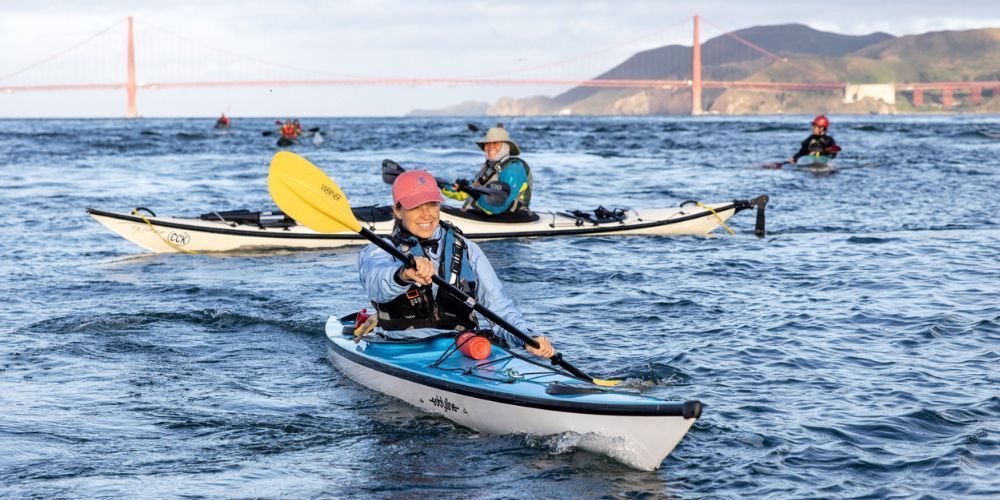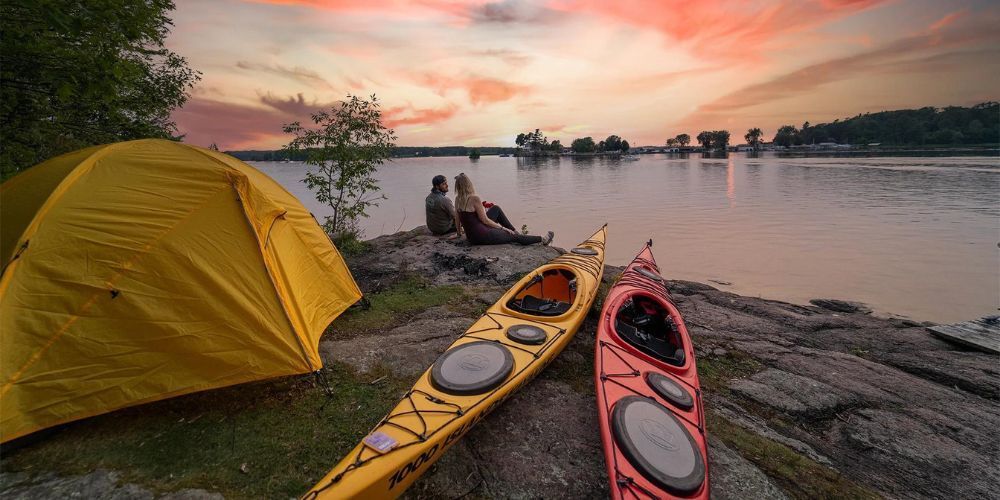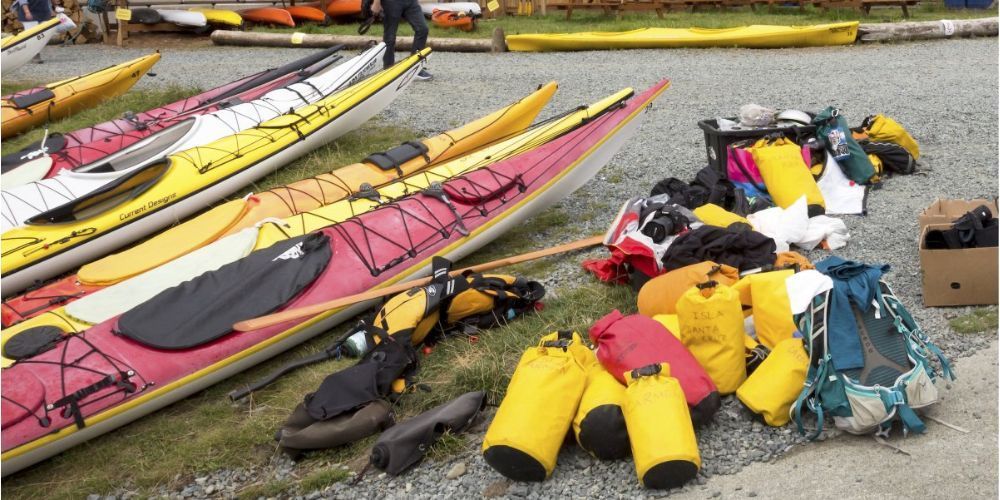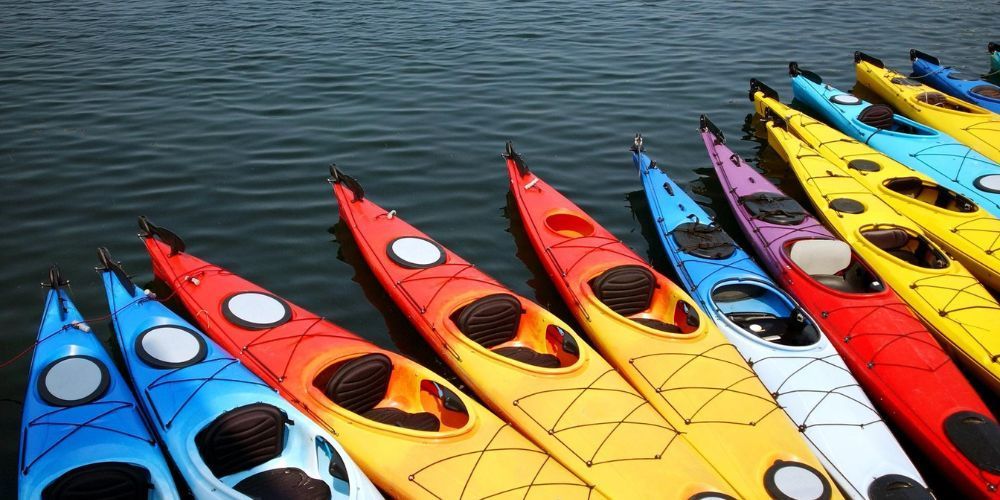Standup Paddle Board Guide: How to Choose the Best SUP for Beginners
Choosing the right standup paddle board as a beginner is a huge step into an exciting world of water and sport. You should focus on two key aspects: material and board length. These elements shape your paddling experience, from stability and speed to portability and durability. A tasty tidbit you might not have known? Epoxy boards can give you an edge in long-distance paddling, perfect for those serene lake explorations. But wait till we dive in, there's more to this than meets the eye.
Stand-up paddle boards come in various types such as all-around SUPs, touring SUPs, surfing SUPs, yoga SUPs, and fishing SUPs. Each type is designed to cater to specific activities and offers unique features to enhance the paddling experience.
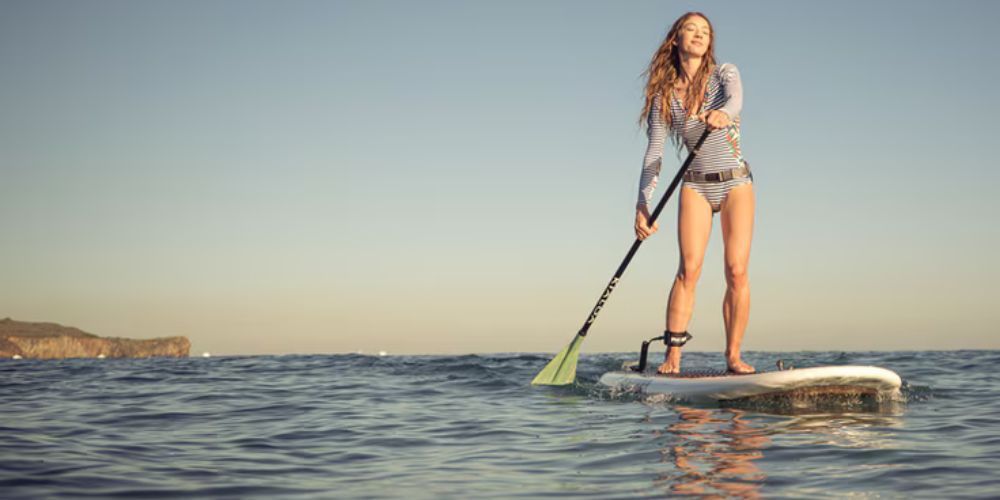
Choosing the Right Paddle Board: Material and Length
When choosing a standup paddle board (SUP), two critical factors to consider are the material used and the length of the board. The material choice significantly impacts the performance and versatility of the board, while the length determines its stability, speed, and maneuverability.
Material Options for Paddle Boards
Standup paddle boards (SUPs) are commonly made of epoxy, fiberglass, carbon fiber, or inflatable materials. Each type has its unique characteristics such as durability, weight, and performance in different water conditions. For instance, inflatable boards are easier to transport and store, making them an excellent choice for convenience and portability. On the other hand, epoxy boards offer optimal performance for activities like surfing, racing, and long-distance paddling due to their rigid construction.
Inflatable SUPs have gained popularity among beginners and travelers due to their portability and user-friendly storage. They are constructed from high-quality PVC material, making them sturdy enough to withstand various water conditions while providing an easy-to-transport solution. In contrast, epoxy boards are more suitable for intermediate to advanced paddlers who prioritize performance in specific water activities.
Considerations for Length
The length of a paddle board plays a significant role in its stability, speed, and maneuverability. Longer boards are generally faster but less maneuverable, making them ideal for long-distance paddling and touring on flatwater surfaces. Conversely, shorter boards provide improved maneuverability and responsiveness, making them well-suited for surfing or navigating small to medium waves.
As a beginner, finding your balance and getting accustomed to paddling is essential. Therefore, a longer and wider board is often recommended for better stability while you learn the basics. A wider board offers more surface area for stability, making it easier to stay balanced as you navigate calm waters or small waves. This enhanced stability allows beginners to gain confidence as they progress in mastering their paddling techniques.
It's akin to picturing a wider board as providing a similar sense of security as a wide bicycle tire compared to its narrower counterpart. It helps distribute your weight more evenly and provides a broader platform for balance - crucial when you're just starting out with standup paddle boarding.
Understanding these two fundamental aspects will aid in making an informed decision when seeking out the best SUP for beginners that suits your preferences and intended paddle boarding activities.
Transitioning from choosing the right paddle board to picking the essential gear and accessories is pivotal in fully embracing the standup paddle boarding experience.
Essential Gear and Accessories for Standup Paddle Boarding
When you're out on the water enjoying your stand-up paddleboard, having the right gear is essential for safety, comfort, and making the most of your experience. Let's take a look at some key pieces of gear that will enhance your paddleboarding journey.
Personal Flotation Devices (PFDs)
Regardless of how well you can swim, wearing a personal flotation device (PFD) is non-negotiable. A PFD is like having a guardian angel with you on the water. It keeps you buoyant in case of an emergency and is especially vital when paddling in open waters or areas with strong currents. There are various types of PFDs available, each with its own unique features:
- Inflatable Belt Packs : These are compact and provide freedom of movement while offering safety when inflated.
- Vests : A traditional choice with ample buoyancy and multiple adjustment points for a secure fit.
- Waist-Worn Options : Designed for paddle sports, these offer high mobility and are comfortable to wear during extended paddling sessions.
Remember, wearing a PFD doesn’t just protect you; it sets a good example for others on the water too.
Leash
It's not just an accessory—it's a lifeline. A leash is an often overlooked piece of equipment but is crucial for safety. When attached to your ankle or calf, it ensures that your board stays within reach if you fall off or lose your balance. In windy conditions or rough waters, a leash prevents your board from drifting away, making it easier for you to climb back onboard when you fall.
The length of the leash is important too. Opt for one that’s long enough to allow freedom of movement while paddling but not so long that it becomes entangled in underwater obstructions.
Sun Protection
Enjoying the sun while on your board? It's vital to protect yourself from harmful UV rays. Wearing UV-resistant clothing, using waterproof sunscreen with SPF 30 or higher, and donning a pair of polarized sunglasses not only protects you from sunburn but reduces glare on the water surface—enhancing visibility while paddling.
As we prepare ourselves with the necessary gear and accessories, let's now delve into some additional items that can elevate our stand-up paddleboarding experience even further.
Mastering SUP Basics: Safety and Technique
When it comes to stand-up paddle boarding (SUP), like any water sport, safety should always be the first consideration. Before you head out on the water, there are some important precautions and techniques to keep in mind to ensure you have an enjoyable and secure time.
Safety Precautions
One of the most crucial aspects of preparing for your paddle boarding adventure is being aware of the weather conditions and forecasts. It’s vital to avoid harsh winds or storms while out on the water. Pay attention to the wind speed and direction, as they significantly influence your paddling experience and stability on the board.
Additionally, always wear appropriate sun protection such as a wide-brimmed hat , sunglasses with UV protection , and reef-safe sunscreen. The sun's reflection off the water can intensify its effects on your skin, making it critical to shield yourself from harmful UV rays.
Furthermore, it's important to be mindful of other watercraft and swimmers. Knowing and abiding by the local rules and regulations of the waterway you are exploring ensures everyone's safety, creating a harmonious environment for all who are out enjoying the water.
Paddling Technique
Mastering proper paddling technique not only enhances your efficiency but also makes the whole experience more enjoyable. Here are some key factors to consider:
- Proper Posture: Maintaining a good posture while standing on the board is critical for balance and endurance. Keep your back straight, shoulders relaxed, and knees slightly bent to absorb shock from waves or choppy water.
- Hand Positioning: When holding the paddle, keep a firm grip with one hand at the top of the paddle handle, while your other hand holds the shaft slightly lower than shoulder-width apart. This allows for maximum efficiency during strokes.
- Whole Body Integration: Effective paddling goes beyond just using your arms. Engage your core muscles and twist your torso with each stroke, using your entire body for propulsion rather than relying solely on arm strength.
By paying attention to these fundamental aspects of paddling technique, you'll find yourself gliding through the water effortlessly, making for an exhilarating experience every time you step onto your board.
Understanding these safety precautions and perfecting your paddling technique will not only ensure you have a safe and enjoyable time on the water but also set you up for success in becoming a proficient stand-up paddleboarder.
As you master the basics of SUP safety and technique, you're now ready to further enhance your paddle boarding journey by maximizing your overall experience on the water.
Maximizing Your SUP Experience on the Water
Stepping onto a stand-up paddle board marks the beginning of your aquatic journey. It's crucial to understand that different water conditions have unique demands, greatly affecting your experience. Calm lakes offer serenity and tranquility, ideal for peaceful paddling sessions. Rivers with gentle currents demand heightened awareness and agility to navigate diverse terrain. Open ocean waters present a more dynamic and challenging environment, testing stability and endurance against waves and changing tides. Being in tune with these diverse water conditions will enhance your experience and empower you to confidently explore various aquatic settings with ease.
Imagine gliding across calm water, feeling the gentle lull of waves beneath you, or conquering challenging waves while maintaining balance and composure. Each distinct environment presents an opportunity to expand your skill set and deepen your connection with nature.
In addition to savoring the natural beauty of each setting, it's essential to recognize the significant fitness and health benefits that stand-up paddle boarding offers. Embracing this activity not only gives a full-body workout but also enhances balance and coordination while offering stress-relief benefits. The rhythmic motion of paddling engages multiple muscle groups, leading to improved strength, endurance, and overall physical well-being. Moreover, the meditative aspect of gliding over tranquil waters promotes mental relaxation and rejuvenation.
Engaging in stand-up paddle boarding regularly can significantly contribute to enhanced physical fitness and overall well-being.
Consider how the serene surface of a calm lake provides a harmonious backdrop for low-impact exercises. Alternatively, maneuvering through river currents challenges your agility and core strength, offering an engaging cardiovascular workout. Conquering open ocean waters demands resilience and adaptability, fostering mental fortitude and perseverance.
By understanding the nuances of various water conditions and embracing the holistic fitness and health benefits of stand-up paddle boarding, you're able to elevate your experience on the water while nurturing your mind and body alike.
Being mindful of the distinct qualities of each water condition enriches your paddle boarding journey in more ways than one. Now, let's embark on a new adventure as we delve into the world of surfing with your paddle board.
Surfing with Your Paddle Board: An Introduction
So, you've decided to take your stand-up paddle boarding to the next level by catching some waves. Surfing with a paddle board can be exhilarating, but it requires a specific type of board designed to handle the waves and provide maneuverability on the water. Whether you're new to surfing or an experienced rider, understanding the characteristics of a surfing SUP (stand-up paddle board) is crucial for a safe and enjoyable experience.
Surfing-specific paddle boards are tailored for the unique demands of riding small to medium waves. Unlike all-around SUPs, which cater to various activities, surfing SUPs prioritize responsiveness and agility to navigate the face of the waves. This means they are generally shorter in length and have a rocker, which is an upward curve in the front of the board, allowing for better wave performance. While an all-around SUP offers stability and versatility for different activities, a surfing-specific paddle board emphasizes speed, quick turns, and optimal maneuverability when riding waves.
Imagine riding ocean swells like a seasoned surfer—responsive and in sync with the waves. That's the experience a surfing-specific paddle board aims to deliver.
When selecting a surfing SUP , it's essential to consider factors such as length, width, rocker design, and fin setup—all of which contribute to its wave-riding performance. These specialized features are engineered to enhance your surfing experience and elevate your skills on the water. If you're looking to transition from standard paddling to hitting the waves, investing in a quality surfing SUP specifically tailored to wave performance is key. It will not only improve your overall experience but also equip you with the right tools for conquering those thrilling moments on the water.
As we broaden our horizons from exploring the nuances of surfing-specific paddle boards , let's now delve into how different SUP designs cater to varied water environments.
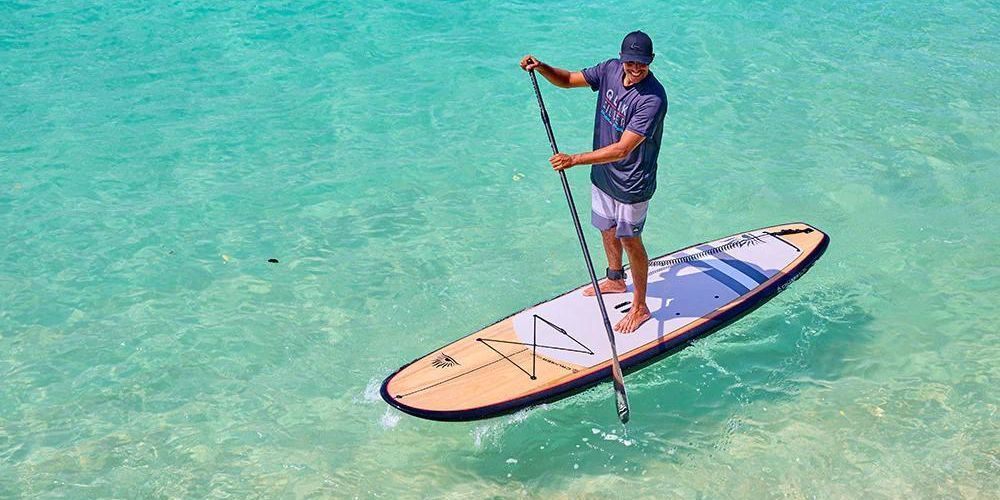
Standup Paddle Boarding: Exploring Various Water Environments
Stand up paddle boarding (SUP) is an exciting and versatile activity that can be enjoyed on various types of water. From the gentle ripples of lakes to the crashing waves of the ocean, paddle boarding offers diverse settings and experiences. Each environment presents its own set of challenges and rewards, underscoring the importance of adapting your approach based on the type of water.
When navigating a calm lake or slow-moving river, an inflatable SUP provides stability and maneuverability, ideal for beginners or those seeking a relaxing day on the water. The wider design and buoyancy of inflatable SUPs make them well-suited for these placid environments. On the other hand, for open waters like coastal areas or ocean surf, a touring SUP may be more fitting due to its longer length and streamlined shape designed for speed and efficiency.
For riding waves in ocean surf, utilizing a surf SUP designed for responsiveness in small to medium waves is crucial. These boards are typically shorter and boast a narrower nose and tail compared to other types of paddle boards, allowing for greater control in dynamic water conditions. Alternatively, for long-distance expeditions or paddling across open water, a racing or touring SUP would be preferable due to its speed, tracking ability, and stability over long distances.
It's crucial to pair the characteristics of the stand up paddle board with the specific demands of the environment you'll be paddling in. This ensures a safe and enjoyable experience while maximizing your time on the water.
Paddle boards are suitable for various water environments, including oceans, rivers, lakes, and other bodies of water. This versatility allows for diverse experiences, from leisurely paddling on calm waters to navigating through challenging conditions like coastal waves or river rapids.
For instance, navigating through river rapids calls for a different type of board than leisurely paddling on a calm lake. River rapids require a whitewater SUP with features such as rocker nose designs and reinforced construction to handle rapid changes in direction and rough terrain without compromising stability.
Ultimately, the type of water environment you plan to explore will guide your choice of stand up paddle board. Each board category brings unique advantages catering to specific conditions, ensuring that your experience aligns with your skill level and desired challenge. By understanding how paddle boards are tailored to different water environments, you can seamlessly select the right board that complements your adventure.
Choosing a stand up paddle board tailored to your desired environment ensures an optimal experience on the water while enhancing your skills as you explore different conditions.
Nature's Playbook
As an Amazon Associate I earn from qualifying purchases.




